
In 1970, Carol Bates Brown, a student at Cal State Northridge, started a student group called Voices in Vital America (VIVA), intending to bring attention to the plight of POWs and MIAs in Vietnam so they wouldn’t be forgotten. They sold nickel-plated and copper bracelets with the names of POWs and MIAs inscribed therein, and the recipient vowed to wear it until that POW or MIA soldier came home. The bracelets sold for $2.50 to $3.00, and five million of them were sold.
I was 14 in 1970, and nearly everyone I knew in my Los Angeles-area high school was wearing one, so I spent part of my allowance on a bracelet. My bracelet arrived and the name I got was SFC Carroll Flora. I wore my bracelet every single day, and I slept in it and showered with it. I wore it so much, I actually wore off some of the finish on the inside of the bracelet, as you can see in the photo.
I wondered about him frequently – was he single or married, where was he from, how old was he, did he have kids, was he alive, what was he doing over there, where was he, etc. Finally, in the spring of 1973, he was released as part of “Operation Homecoming,” with the return of 591 American POWs following the Paris Peace Accords. At last I could take off my bracelet, so I stuck it in my jewelry box and didn’t think about it for many years.
When computers and the Internet came to be, I looked him up to see whatever became of him, but I didn’t have any luck. Fast-forward to the passing of John McCain this past August, and I found myself thinking about Sgt. Flora again. This time I found his obituary online and it had the names of his son and daughter and I found them on Facebook. I message them and his daughter responds, so we exchange email addresses and start corresponding. She was very kind and she shared so much information with me that I became overwhelmed with emotion.
At the age of 26, Sgt. Flora went to Vietnam in 1967 as part of the 5thSpecial Forces Group MASC SOG. He and his platoon were on a mission when their helicopter, unknowingly acting on bad intel, dropped them just one mile from the Viet Cong. They radioed for a rescue and waited, as the Vietcong were getting closer.
Because there was no time to land, the rescue helicopter dropped a crude sling into which the soldiers jumped. Flora got all his men into the sling but, as he was jumping in, he got shot in the wrist and the bullet traveled up his arm and out his elbow and then he was hanging on with one arm. As the helicopter flew away, Sgt. Flora fell 120 feet and was knocked unconscious.
He was soon captured by the Viet Cong, and he was beaten and tortured. He escaped once and was beaten and tortured again. While in captivity, he was kept in holes and bamboo cages, and tied to whatever they could tie him to. Ultimately, he was a prisoner for 2,055 days (5.6 years). He came home two inches shorter, 60 pounds lighter and with permanent injuries from the torture and beatings he endured.
Before Sgt. Flora went to Vietnam, his wife was a homemaker, his daughter was eight and his son was a baby, but when he came home in 1973, everything had changed. He came home to an independent, self-sufficient wife, a teenage daughter and a seven-year old. His wife had become an activist and she was President of the Maryland chapter of POWs/MIAs and had traveled to Paris for the peace talks. They tried to make their marriage work, but it only lasted four years and although they divorced, they remained friends for the rest of their lives. He lived out his life in Arizona and died in 2013.
You’d think that would be the end of the story, but I still had the bracelet and I was trying to figure out what to do with it. His daughter said she’d take it for her grandson and keep it with her collection (she has several), but I found another place for it – the Palm Springs Air Museum (PSAM).
I did some online research and, in a chat forum, I found the name of Dave Thompson who is associated with the Palm Springs Air Museum. Dave has created a permanent exhibit for POW/MIA bracelets to honor and thank these Vietnam vets who served their country, but were never properly thanked. Dave told me that deceased Vietnam veterans have their memorial in Washington D.C., but the POWs and MIAs that survived Vietnam never got their own memorial and that’s what motivates him.
He’s collected over 1,000 bracelets so far. What’s remarkable about this exhibit is that he’s combining the story of the POW/MIA with the wearer of the bracelet to include a short bio and photograph of both, which gives the exhibit an added dimension. I didn’t hesitate to send Dave the bracelet, my photo from my sophomore year in high school, and my bio, which says:
“Susan was 14 years old and living in Palos Verdes, California, when she purchased Sgt. Flora’s bracelet with her allowance money in 1970. ‘I wore it every single day for three years – swimming, showering and sleeping with it on my wrist. I frequently wondered who this man was, where he was, how old he was, whether he was married with kids, what he was doing over there and if he was safe. It was surprising that I could care so much about a man I never met and knew nothing about. I never took my bracelet off until he was released and came back home in 1973.’ Susan kept her bracelet for 45 years before kindly donating it to the Palm Springs Air Museum and said, ‘I still hold the memory of this serviceman in my heart.’”
Between connecting with Sgt. Flora’s children, the research I’ve done, and talking with Dave Thompson at the Air Museum, it’s been an emotional journey for me. I’ve got closure now, and I’m especially honored that my bracelet can be part of this important exhibit.
* Of the 2,500 POWs and MIAs, there are still 1,200 whose bodies have never been recovered.
Written by Susan 11/13/18
